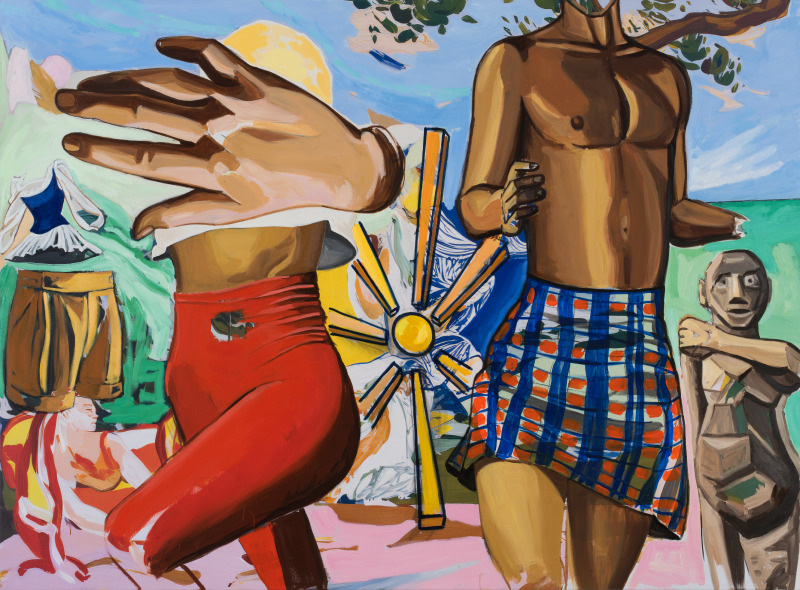David Salle, Poster Boy of the Post Modern, Embraces the Vocabulary of the Digital Age
Salle seems interested in showing us the myriad ways in which painting can engage the act of seeing.

‘David Salle: New Pastorals’
Barbara Gladstone Gallery, 515 West 24th Street
Through November 2, 2024
An art star who rose to towering prominence in the heady days of the 1980s, David Salle, has a bold new painting show at Barbara Gladstone called “New Pastorals.” Part of the brash cohort of Julian Schnabel, Jeff Koons, and Eric Fischl, Mr. Salle has always been the most reclusive painter of the group. He was quiet when his colleagues were loud, reclusive when they were self-promoting. Instead he has chosen to tread on his own singular, enigmatic path, exploring painting in ways that have challenged both its history and its provenance.
The lion’s share of his energy, in other words, has been directed towards challenging the fundamentals of painting since the start of his career. He began with the juxtaposition of seemingly unrelated objects, patterns, abstract elements, and figures, placing them in shared visual spaces that often-radiated tension and unease.
Technically assured, he created exquisitely polished canvases where figures were placed alongside objects, patterns, and other assembled detritus of consumer culture. He became the poster boy par excellence of what popular culture called the “Post Modern,” which was meant to signify unusual combinations of historical and contemporary, old and new, high and low.
There is much more to Mr. Salle’s bid to open the space of painting, however. Ever experimental, his new series, which he calls the “New Pastorals” are based on an older series of paintings recycled through AI with the engineer Grant Davis. This created convoluted digital backgrounds where elements of the earlier paintings are recycled: a mountain range or stand of trees here, a fragment of pattern or a piece of a figure there.
This is as far as the AI goes however. Mr. Salle has simply used the digital as a springboard for what he has always done best, which is painting by hand. He is incorporating the vocabulary of the digital age to continue his life-long project: using painting to get at the feeling tone that underlies our age. In this case he appears to be specifically getting at the overlap of human and machine artifice, with certain hand painted elements at times overlapping and at other times almost indistinguishable from their digitally reproduced and printed counterparts.

In the past, the feeling tone of Mr. Salle’s paintings has been cold, if not downright sinister. These bright new paintings, however, seem much more concerned with an underlying sense of possibility and freedom. Each work swirls and bends its elements into a compositional vortex. The eye doesn’t enter the painting so much as get sucked into its curvilinear surfaces.
There is no up and down in these paintings, they are unmoored as a Baroque ceiling fresco. One can be underneath and above a figure on the same plane, which has the effect of making the compositional space seem boundless. If Mr. Salle’s early work was nearly forensic, these paintings are wild and wide open. This openness is supported by his engaging palette of sophisticated color contrasts, cerulean with bright yellow, crimson with forest green, pale pink with mint and lavender. The palette engages the eye as much as the figuration.
Yet even as the welter of topsy-turvy elements pirouette around, it retains a sense of visual logic and Mr. Salle’s tight, clinical tidiness. In “New Pastoral, Enchanted Forest,” a large flesh colored hand, worthy of Bernini, appears to be reaching beyond the surface of the painting. Except that there are tears in the hand that peer through to the background behind it, as if, in all its fleshly rendering, it is something filmic and transparent. A full-figured woman in a red dress floats sideways above it. All of these elements are nestled inside a forested glen, though its grounding in a landscape does nothing to reassure us. If anything, it is more filmic and theatrical than anything else.
This appears to be the point. Mr. Salle is using the orientation of “landscape” but in quotes, just as some of his figural and patterned elements hover on the knife edge of abstraction. Motifs haunt the series, as if he were relentlessly trying out different compositional combinations. An Italianate hand, the same from “Enchanted Forest” makes repeated appearances in other paintings, at different scales, gesticulating. There is also a totem-like statue, oddly reminiscent of Matisse, and a bright cartoon sun whose rays appear to be French fries. It is as if Mr. Salle was continuously asking “what would happen if I placed this here? Or here?”
He also revels in rendering something in all its palpable fullness and then subverting it. Mr. Salle is a master of the figural fragment. Figures and objects pop in hyperreal fashion in the foreground, only to be set a mass of deconstructed and rough gestural brushstrokes. Paintings sport limbs and torsos bursting with vitality but also strange anonymity.
Sometimes the body is missing entirely, with only a fabric outfit to give us a feel of the figure within it, as in the painting “New Pastoral: Ballerinas.” Bright fabric patterns and plaid, in fact, take up dramatic space in many works on almost an abstract level, even as they evoke traces of visual and cultural association.
Rendering and technique, in other words, are simply so many devices in his broad arsenal of tricks. Together with his theatrical sense of composition and his scintillating palette, it appears Mr. Salle is interested in showing us the myriad ways in which painting can engage the act of seeing. After nearly four decades, Mr. Salle remains most seriously engaged with the drama of what painting can do.

